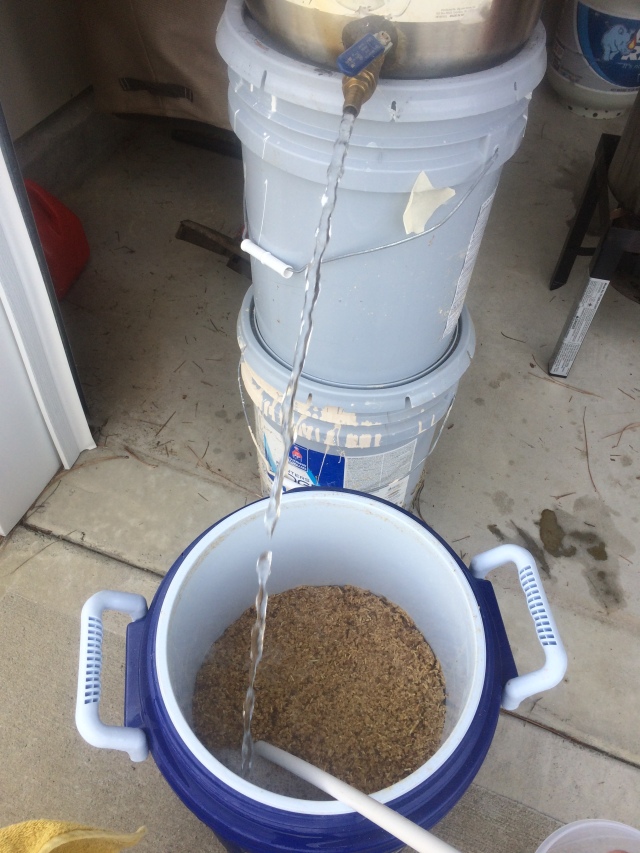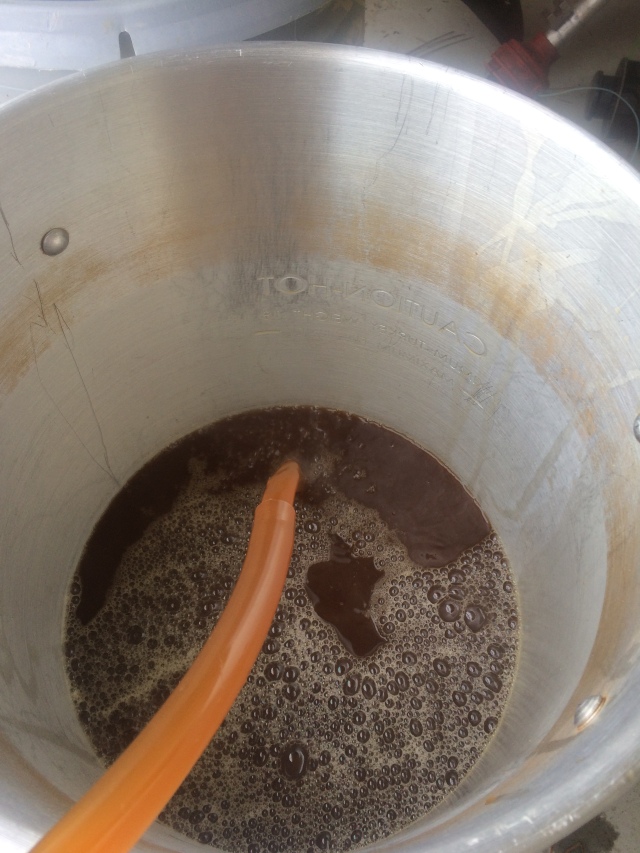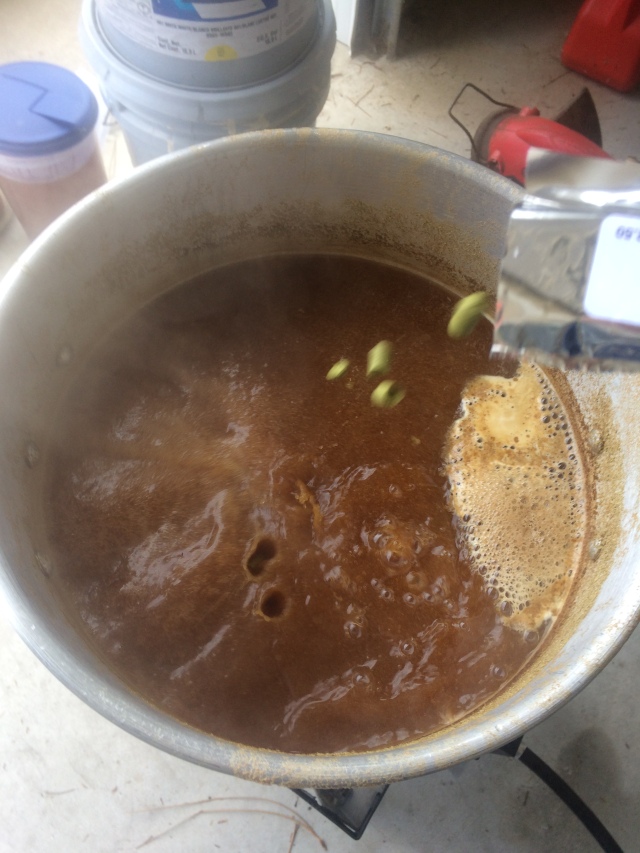This post is one in a series of making small adjustments to a single recipe in order to improve it, learn more about the impact each ingredient has on the finished product, and the art of recipe creation. The rest of the series can be found here.
Brew Day
Take a step back. Regroup. Try again.
After the outcome of Iteration 3, that’s exactly what I had to do. That’s what this brew day was about. I knew it was likely to happen eventually in this process. If I kept every change I made to this recipe, instead of implying that they were all the right decisions, it would more likely indicate that I wasn’t actually learning from my experiences but just going with the flow. Yes, this brew day was a step back, but I went into it hoping it would allow me to step forward in the right direction this time.

What would a brew day be without some sort of misstep, though? This particular misstep was a repeated error. Just as I did with Iteration 3, I gathered too much wort and ended up with a lower than expected OG. I gathered 6.5 gallons of wort to boil, which is what I gathered last time. I would have sworn, though, that this was the volume I always collected.
A few possibilities crossed my mind. I recently started using a wort chiller instead of an ice bath. Because of the more rapid cooling process, I wondered if the wort wasn’t experiencing as much evaporation as it had before with the (much lengthier) ice baths I used previously. The length of time the wort spent at a high enough temperature for evaporation to occur had certainly been significantly shortened; however, I can’t imagine I was truly losing a half gallon of wort to post-boil evaporation prior to buying an immersion chiller. I also have to deal with the fact that I did hit my OG in Iteration 2, and I feel somewhat confident that I collected the same amount of pre-boil wort for all of the batches in this series.
However, gathering more wort pre-boil than I had in the past seems like an obvious possibility. I suppose this is possible, but I can’t guarantee it because I have never written down my pre-boil volume. I had just always gathered the same amount (or so I thought). But perhaps I misremembered somewhere along the way and became convinced that the misremembered number was the correct number. I just don’t know. Up to this point I thought I took good notes, but this has proven me wrong.
The other possibility I considered was a change in my boil-off rate. I boiled with the same vigor that I always have, so perhaps the humidity was higher these last two brew days. It is getting into the warmer days in South Carolina, so the humidity can get a little out of hand.
Thoroughly confused, I solemnly vowed to begin keeping track of the pre-boil volume collected and humidity level. And then I realized that I had my recipe calculator set to a 5 gallon batch instead of 5.5, which is what I’ve been gathering to account for trub loss across the process. That was just me being careless. However, I know for a fact that the recipe calculator has always been set to this, so the other factors still came into play. At least it wasn’t all because of my stupidity. If nothing else, I’ve learned I do need to take notes on a few more aspects of my brewing if I ever want to be consistent.

Recipe
As was my goal in Iteration 3, I hoped to bring a certain complexity and a deeper richness to this beer this time around. While I had achieved richness and complexity in the last version of this red IPA recipe, the raisin flavor I got was not something I wanted to keep around. The Special B in Iteration 3 added a level of complexity that was good, but the quality of that complexity was not in keeping with my end goal for what this brew should be. I do want dark fruit notes to be fairly prominent in the malt flavor, but I want these to be cherry and plum flavors. The raisin notes from my last brew clashed with the citrus hop character and overpowered it. The dark fruit character should be rich and deep, and it should be complimented by the bright citrus character of the hops. That said, the Special B had to go.

This left me with two questions from the last brew:
- What grain should I use in place of the Special B that will yield richness and complexity when combined with the C120?
- Should I keep the amount of C120 the same, return it to its former amount, or use more than I have before?
This opened up a world of options, so I returned to those malts I had considered before. To add the complexity I was looking for, I thought about adding some Victory, Munich, or Vienna. I also considered replacing some of the 2-row with Marris Otter. As I considered the flavors I wanted to add, Victory quickly dropped to the bottom of my list. I generally like Victory, but the biscuit-like character wasn’t something I thought would help me achieve my end goal.
Marris Otter was next on the chopping block. I’m not against bringing some into this recipe to see what it could add, but the deciding factor here was the strength of flavor. The Special B in my last brew lent a strong character to the beer, and although it wasn’t the flavor I wanted, the strength of it was what I think yielded the complexity of Iteration 3. Perhaps the Marris Otter would give me this, but I decided to try something with a more pronounced flavor first—and also, I had to have some reason to decide, so this may have ended up being a decision based on a whim more than anything.
For the same reason as above (strength of flavor) I decided to try Munich over Vienna. My LHBS had a floor-malted dark Munich that sounded promising, so I decided to give that a shot. For the record, I’ve seen other malts listed as “dark Munich” that were 20⁰+ Lovibond. This particular “dark” Munich is listed as 8⁰L. That’s only one degree darker than the specs for the “light” Munich my LHBS also sells, so truthfully, it was the floor-malted preparation of this malt that sold me.
The final piece I had to decide was the amount of C120 to include. I wanted to have at least the same amount of dark fruit flavor I got from Iteration 2, but decided that I’d try to get just a bit more of that flavor. To do this, I kept the same weight of grain I had in the first two iterations and moved 0.25 lbs. from the 2-row to the C120. I then replaced 1 lb. of 2-row with the Munich. I hoped that this would give me the complexity I wanted with just a bit more plum/cherry character than Iteration 2 gave me.
- Mashed at 150⁰ F for 1.25 hrs.
- 9 lbs. 2-Row
- 1.25 lbs. Crystal 120
- 1 lb. Dark Munich
- Boiled for 1 hr.
- 0.5 oz. Simcoe (60 min) at 12.2% AA
- 0.5 oz. Simcoe (30 min) at 12.2% AA
- 0.5 oz. Cascade (15 min) at 5.0% AA
- 0.5 oz. Centennial (5 min) at 9.7% AA
- Pitched US-O5
- OG: 1.052
- FG: 1.010
- ABV: 5.5%
- Dry hopped 0.5 oz. Cascade and 0.5 oz. Centennial for 5 days.
- Bottled and primed with 4 oz. of priming sugar.
Tasting
Outside of being fairly disappointed that what was intended to be IPA strength ended up at 5.5% ABV, I tried to go into this tasting concerned with the flavors that were present instead of worrying about the strength. I’ll deal with that on the next brew when I attempt to fix this efficiency issue I’ve had on the last two iterations.
Although this beer was an estimated 17 SRM, it seemed lighter in color than Iteration 3, which was estimated to be 16 SRM. Estimates and one degree SRM aren’t items I’m going to be overly confident about, but I assumed that these beers would be similar in color, or at least darkness. Whatever the reason, this beer is red, but it leans more copper and amber than the dark red of Iteration 3.

The aroma of this beer had the familiar citrus and floral hop notes I’ve become accustomed to with this combination and hop schedule that I’ve yet to change throughout the various versions of this recipe. The difference this time was in the malt aroma that accompanied the hops. There was a definite breadiness in the nose.
The flavor mimicked the aroma with citrus, floral, and bready character being the first things I noticed. The next thing I noticed was the absence of the dark fruit character that I’ve come to expect from C120. However, as the beer warmed up, I did begin to get hints of plum, although it was fairly subdued amongst the other flavors. What surprised me the most from this beer was a roasty flavor cutting through the otherwise bready flavor of the malt.
Goals for the Next Brew
I knew Munich had a strong flavor, but what I was not expecting was that it would cover up the dark fruit flavors I have gotten before from the C120. The bready character was nice, but it was far too much to work with the end goal of this recipe. I truly want the plum and dark cherry notes I’ve gotten before to be the highlight of the malt character, but they also need to be balanced and supported by some complexity. The Munich malt added, but it simultaneously subtracted by covering over the flavors I want. It’s not a bad flavor for this recipe, but the breadiness needs to be toned down, and the C120 needs to be allowed to shine through.
Regarding the C120, I’ve not gotten roastiness from this malt before, but I think this time I added too much of a good thing. At 120⁰ Lovibond, it seems reasonable that this roast flavor could come from this malt, and as I have no other dark malts in this grain bill, it was really the only possible place this flavor could be coming from. This leads me to believe that the extra 0.25 lbs. of C120 I added pushed it over the edge. Perhaps this is another reason I didn’t get much of the dark fruit character from this malt this time around. It’s possible with the additional percentage I included that the roast became more prevalent and covered the other flavors that were present when the C120 was used in smaller quantities.
In addition to these malt characteristics, this beer also lacked some of the richness that Iteration 3 had. I would like to bring that back without adding the raisin character I got from the Special B in that version’s recipe.
The questions I’m left with as I go forward are these:
- How do I tone down the breadiness while maintaining the current malt complexity?
- How can I make the malt character richer without it clashing with the hops?
- How do I eliminate the roasted character of too much C120 while getting more dark fruit flavor than I got before?
